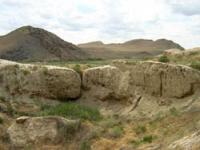You are here
Medieval Kendge.

Tour Historic Monuments of Turkestan.
"Between Farab, Kendgida and Shash there are good pastures and about a thousand Turk families who have already adopted Islam"
Arab geographer of the Xth century, Ibn Hawqal.
Ancient Cities Tour to Kazakhstan.
Up until the middle ages life was bustling onn the Arys river in South Kazakhstan. The ancient cities of Kang (Kangdizh), Usbaniket, Karasaman and Khaladge-Karasaman were located here, in the region of Kendgida or Kenge.
During the Chagatai dynasty of the XIIIth - XIVth centuries it was renowned for minting. Today this land is host to many ancient settlements and cemeteries. Along the border between Iran and Turan, on the left side of the Arys River, archaeologists have found unique written documents carved into brick tiles on a site of the ancient settlement Kultobe.
Booming Subaniket.
The outstanding Arab geographer of the Xth century, Ibn Hawqal, wrote about the remote cities and countries at the very edge of the populated Muslim universe, noting that, "Between Farab, Kendgida and Shash there are good pastures and about a thousand Turk families who have already adopted Islam".
He named Subaniket the main city of Kendgida. The anonymous author of the geographical essay Hududal-Alem (Xth century) noted that, "Subaniket is a blooming, rich city".The medieval traveller al-Maqdisi wrote that Subaniket was a large, clean, fortified city with a mosque and constructions in the suburbs.
Based on the discovery of particular sources of information, researchers established the borders of this blooming land in the mid Arys - a tributary of Syrdarya, the largest river in South Kazakhstan.
Scientists discovered in the ancient settlement two-roomed houses built from mud bricks with the floor, hearth and larders. Its lower layer dates back to the Ith - VIth centuries A.D., the middle to the VIth - VIIIth centuries and the upper eroded layer to the IXth - Xth centuries.
That means that life was in full swing during these X centuries!
Talking Ceramics.
Most of the ceramics have been found during excavations at the place where the ancient Subaniket was situated. Interesting finds in the middle level are terracotta figures. One of them depicts a hook-nosed man wearing a round flat hat, who had straight shoulders and hands facing downwards.
The second figure is shaped like a small icon of a man with a large hooked nose and large, almond-shaped eyes.The man's hair is standing on end; he has a moustache and is dressed in an oriental robe with its lap decorated with a vertically lined strip.
He holds a mace in one hand and a rod in the other. The third figure depicts a man wearing a tall hat. An ancient Sasanian silver coin as well as a bronze mirror was found in the ancient settlement.
However, more interesting findings were discovered in the Borizhar cemetery that adjoins Subaniket. Borizhar is the largest ancient cemetery in South Kazakhstan, with over a thousand burials of different types and epochs; from burial mounds to vaults and catacombs.
The excavation of the vaults revealed many household items, such as ceramics, iron swords, decorations and luxurious Hun-Avar type belts and the Turkic-Sogdian type dishes of the VIth - VIIIth centuries.
Many of these burials were plundered, but the discovered items give an idea of the ancient Kendgida residents' appearance and life.
Mysterious Inscriptions.
In the post-Mongolian period of the XIIIth - XIVth centuries the Kengida district changed its name to Kendge and became renowned for minting the Chagatai dirham. By that time Karasaman or Karaspan city became the capital of the region and today there is a corresponding ancient settlement site on the western suburb of the village with the same name. Archaeological expeditions have been taking place in the ancient settlement of Karasaman since 2004.
A huge number of very interesting ceramic items were discovered here as well as a coin collection dating back to the XVIth - XVIIIth centuries. Unfortunately, these once booming medieval cities fell into decay, and one of the reasons was the Kazakh-Dzungarian wars that caused storms and destruction.
The Kendge region left its descendants very interesting monuments - the most ancient being the written language called, in scientific circles, Kultobe inscriptions. One tile remained almost intact.
For a long time scientists have tried to read the text on the tile. The English orientalist Nicolas Sims-Williams decoded the inscriptions, and the French researcher Frantz Grenet explained the meaning.
According to the tile's text, the leader of the united army of the four main cities (states of Central and South Sogdiana) - Samarkand, Kish, Nahshab and Bukhara - built the city on the place of the ancient settlement Kultobe.
The city was built in the land of nomads, in Kangju state, and obviously it was a political step to establish the border of their new domains along the Arys River. The inscriptions of Kultobe underlie one of plots of the famous epic poem Shahnameh by Ferdowsi that tells of the Iranians marching to the Turan country where the ancient Kang city of Kendge once stood.
Authority:
Karl Baipakov. Magazine "Tengri" 1, 2012.







